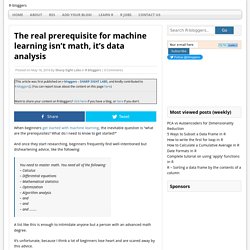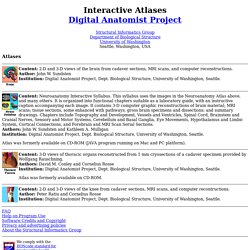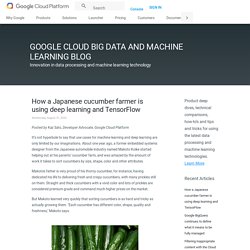Zoom
Trash

Shadow Government Statistics - Home Page. The real prerequisite for machine learning isn't math, it's data analysis. When beginners get started with machine learning, the inevitable question is “what are the prerequisites?

What do I need to know to get started?” And once they start researching, beginners frequently find well-intentioned but disheartening advice, like the following: You need to master math. You need all of the following: – Calculus – Differential equations – Mathematical statistics – Optimization – Algorithm analysis – and – and – and …….. A list like this is enough to intimidate anyone but a person with an advanced math degree. It’s unfortunate, because I think a lot of beginners lose heart and are scared away by this advice. If you’re intimidated by the math, I have some good news for you: in order to get started building machine learning models (as opposed to doing machine learning theory), you need less math background than you think (and almost certainly less math than you’ve been told that you need).
But you’re not entirely off the hook. There are still prerequisites. Related. Eriklindernoren/ML-From-Scratch: Bare bones Python implementations of various Machine Learning models and algorithms. Digital Anatomist Interactive Atlases. Structural Informatics GroupDepartment of Biological StructureUniversity of Washington Seattle, Washington, USA Atlases Content: 2-D and 3-D views of the brain from cadaver sections, MRI scans, and computer reconstructions.Author: John W.

SundstenInstitution: Digital Anatomist Project, Dept. Biological Structure, University of Washington, Seattle. Content: Neuroanatomy Interactive Syllabus. Atlas was formerly available on CD-ROM (JAVA program running on Mac and PC platform). Content: 3-D views of thoracic organs reconstructed from 1 mm cryosections of a cadaver specimen provided by Wolfgang Rauschning.Authors: David M. Atlas was formerly available on CD-ROM. How a Japanese cucumber farmer is using deep learning and TensorFlow. Posted by Kaz Sato, Developer Advocate, Google Cloud Platform It’s not hyperbole to say that use cases for machine learning and deep learning are only limited by our imaginations.

About one year ago, a former embedded systems designer from the Japanese automobile industry named Makoto Koike started helping out at his parents’ cucumber farm, and was amazed by the amount of work it takes to sort cucumbers by size, shape, color and other attributes. Makoto's father is very proud of his thorny cucumber, for instance, having dedicated his life to delivering fresh and crispy cucumbers, with many prickles still on them. Straight and thick cucumbers with a vivid color and lots of prickles are considered premium grade and command much higher prices on the market.
But Makoto learned very quickly that sorting cucumbers is as hard and tricky as actually growing them. Cucumbers from Makoto's farm and ones from retail stores "The sorting work is not an easy task to learn. The many uses of deep learning. Neural networks and deep learning. Computational and Inferential Thinking.